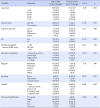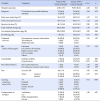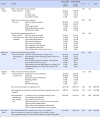Abstract
Purpose
This comparative descriptive study was to identify gender differences in delay seeking treatment and related experiences in patients with acute myocardial infarction (AMI).
Results
Mean age of 47 women was 71.5±13.3 while that of men was 55.0±10.9 (p<.001). More women lived alone and were jobless, less educated, and poorer than men. Men were likely to be 'current smokers' and drink alcohol, however viewed themselves healthier than women (p=.030). Women's hospital stay was 9.23±21.04 days while men's was 4.86±2.72 days (p=.014). More women had been diagnosed with hypertension (p=.040). Women appeared to report significantly less pain (6.46±3.1) than men (8.44±1.8). More men described their pain as sudden onset (p=.015) and chest pain as major symptom (p=.034) than women. More women were found alone upon onset of symptoms (p=.023) and had important reasons for delay seeking treatment (p=.021) than men. Median time from onset of symptoms to seeking medical service was 1.5 hours for men and 5.1 hours for women (p=.003). Median time taken from onset of symptoms to hospital for therapy was 3.5 hours for men and 9.1 hours for women (p=.019).
Figures and Tables
References
1. Statistics Korea. 2013 Annual report on the cause of death statistics [Internet]. Seoul: Statistics Korea;2014. cited 2014 September 15. Available from: http://kostat.go.kr/portal/korea/kor_nw/2/6/1/index.board?bmode=read&bSeq=&aSeq=330181&pageNo=1&rowNum=10&navCount=10&currPg=&sTarget=title&sTxt.
2. Le May MR, Davies RF, Dionne R, Maloney J, Trickett J, So D, et al. Comparison of early mortality of paramedic-diagnosed ST-segment elevation myocardial infarction with immediate transport to a designated primary percutaneous coronary intervention center to that of similar patients transported to the nearest hospital. Am J Cardiol. 2006; 98(10):1329–1333. DOI: 10.1016/j.amjcard.2006.06.019.

3. Steg PG, Bonnefoy E, Chabaud S, Lapostolle F, Dubien PY, Cristofini P, et al. Impact of time to treatment on mortality after prehospital fibrinolysis or primary angioplasty: data from the CAPTIM randomized clinical trial. Circulation. 2003; 108(23):2851–2856. DOI: 10.1161/01.CIR.0000103122.10021.F2.

4. Cannon CP, Gibson CM, Lambrew CT, Shoultz DA, LevyD , French WJ, et al. Relationship of symptom-onset-to-balloon time and door-to-balloon time with mortality in patients undergoing angioplasty for acute myocardial infarction. JAMA. 2000; 283(22):2941–2947.

5. Levine GN, Bates ER, Blankenship JC, Bailey SR, Bittl JA, Cercek B, et al. 2011 ACCF/AHA/SCAI guideline for percutaneous coronary intervention. a report of the American College of Cardiology Foundation/American Heart Association Task Force on practice guidelines and the Society for Cardiovascular Angiography and Interventions. J Am Coll Cardiol. 2011; 58(24):e44–e122. DOI: 10.1016/j.jacc.2011.08.007.
6. Korean Health Insurance Review & Assessment Service. Evaluation result of acute myocardial infarction [Internet]. Seoul: Korean Health Insurance Review & Assessment Service;2013. cited 2014 February 3. Available from: http://www.hira.or.kr/re/diag/asmWrptPopup.do?evlCd=01&pgmid=HIRAA030004000000.
7. Hwang SY. Comparison of clinical manifestations and treatment-seeking behavior in younger and older patients with firsttime acute coronary syndrome. J Korean Acad Nurs. 2009; 39(6):888–898. DOI: 10.4040/jkan.2009.39.6.888.

8. Goldberg RJ, Steg PG, Sadiq I, Granger CB, Jackson EA, Budaj A, et al. Extent of, and factors associated with, delay to hospital presentation in patients with acute coronary disease (the GRACE registry). Am J Cardiol. 2002; 89(7):791–796.

9. Nguyen HL, Saczynski JS, Gore JM, Goldberg RJ. Age and sex differences in duration of prehospital delay in patients with acute myocardial infarction: a systematic review. Circ Cardiovasc Qual Outcomes. 2010; 3(1):82–92. DOI: 10.1161/CIRCOUTCOMES.109.884361.
10. Moser DK, McKinley S, Dracup K, Chung ML. Gender differences in reasons patients delay in seeking treatment for acute myocardial infarction symptoms. Patient Educ Couns. 2005; 56(1):45–54. DOI: 10.1016/j.pec.2003.11.011.

11. LeMone P, Burke K, Bauldoff G, Gubrud P. Nursing care of patients with coronary heart disease. Medical-Surgical Nursing: Clinical reasoning in patient care. 6th ed. New Jersey: Pearson;2015. p. 887.
12. Kosuge M, Kimura K, Ishikawa T, Ebina T, Hibi K, Tsukahara K, et al. Differences between men and women in terms of clinical features of ST-segment elevation acute myocardial infarction. Circ J. 2006; 70(3):222–226. DOI: 10.1253/circj.70.222.

13. McNamara RL, Wang Y, Herrin J, Curtis JP, Bradley EH, Magid DJ, et al. Effect of door-to-balloon time on mortality in patients with ST-segment elevation myocardial infarction. J Am Coll Cardiol. 2006; 47(11):2180–2186. DOI: 10.1016/j.jacc.2005.12.072.

14. Dracup K, Moser DK, Eisenberg M, Meischke H, Alonzo AA, Braslow A. Causes of delay in seeking treatment for heart attack symptoms. Soc Sci Med. 1995; 40(3):379–392.

15. Dracup K, Moser DK. Beyond sociodemographics: factors influencing the decision to seek treatment for symptoms of acute myocardial infarction. Heart Lung. 1997; 26(4):253–262.

16. Gook HI, Joung MH, Im SR, Park HY. Current trend of acute myocardial infarction in Korea (From Korea Acute Myocardial Infarction Registry between 2006–2013). 2014. Available from: http://www.cdc.go.kr/CDC/contents/CdcKrContentLink.jsp?fid=31&cid=60873&ctype=6.
17. Park JS, Kim YJ, Shin DG, Jeong MH, Ahn YK, Chung WS, et al. Gender differences in clinical features and in-hospital outcomes in ST-segment elevation acute myocardial infarction: from the Korean Acute Myocardial Infarction Registry (KAMIR) study. Clin Cardiol. 2010; 33(8):E1–E6. DOI: 10.1002/clc.20557.

18. Rosamond W, Flegal K, Friday G, Furie K, Go A, Greenlund K, et al. Heart disease and stroke statistics-2007 update: a report from the American Heart Association Statistics Committee and Stroke Statistics Subcommittee. Circulation. 2007; 115(5):e69–e171. DOI: 10.1161/CIRCULATIONAHA.106.179918.
19. Kim YJ, Kwak CY. Prevalence and associated risk factors for cardiovascular disease: findings from the 2005, 2007 Korea National Health and Nutrition Examination Survey. Korean J Health Promot. 2011; 11(3):169–176.
20. King KB, McGuire MA. Symptom presentation and time to seek care in women and men with acute myocardial infarction. Heart Lung. 2007; 36(4):235–243. DOI: 10.1016/j.hrtlng.2006.08.008.

21. Moser DK, Kimble LP, Alberts MJ, Alonzo A, Croft JB, Dracup K, et al. Reducing delay in seeking treatment by patients with acute coronary syndrome and stroke: a scientific statement from the American Heart Association Council on cardiovascular nursing and stroke council. Circulation. 2006; 114:168–182. DOI: 10.1161/CIRCULATIONAHA.106.176040.
22. Lee KH, Jeong MH, Ahn YK, Kim JH, Chae SC, Kim YJ, et al. Sex differences of the clinical characteristics and early management in the Korea Acute Myocardial Infarction Registry. Korean Circ J. 2007; 37(2):64–71. DOI: 10.4070/kcj.2007.37.2.64.

23. Chung HJ. Symptoms and response related to treatment-seeking time among patients with acute myocardial infarction. [master's thesis]. Seoul: Ewha Womans University;2008. 37–42.
24. Oh HS, Jang KS, Jeong MH. Decision tree model of treatmentseeking delay among patients with acute coronary syndrome. Korean J Health Promot Dis Prev. 2008; 8:235–244.
25. MacInnes JD. The illness perceptions of women following symptoms of acute myocardial infarction: a self-regulatory approach. Eur J Cardiovasc Nurs. 2006; 5(4):280–288. DOI: 10.1016/j.ejcnurse.2006.02.003.

26. Song YB, Hahn JY, Gwon HC, Kim JH, Lee SH, Jeong MH, et al. The impact of initial treatment delay using primary angioplasty on mortality among patients with acute myocardial infarction: from the Korea acute myocardial infarction registry. J Korean Med Sci. 2008; 23(3):357–364. DOI: 10.3346/jkms.2008.23.3.357.





 PDF
PDF ePub
ePub Citation
Citation Print
Print






 XML Download
XML Download